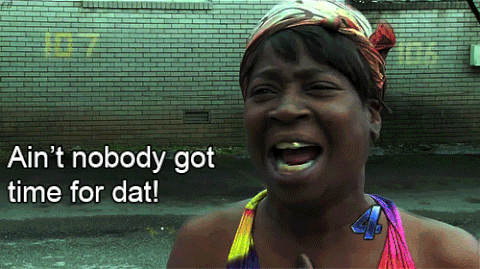
Until recently, when somebody advised me to work on my own marketing and take the time to review my marketing strategy, this was my natural reaction:

We had stuff to do, right? Clients, meetings, deadlines, the dishes…
But that was before anyone knew that a pandemic could bring an entire world economy to a halt.
As bad as things are, I try not to worry too much, since there’s not so much a copywriter can do about pandemics anyway. Instead, I try to make the best of it: work for my clients when I can, but also work on my business.
I believe this is true for any marketer today, whether you are a freelancer or an in-house marketing professional. This is the time to do the things you never had time for: dust off your brand identity, work on your company message, and see if your marketing strategy still resonates with your audience.
I like to call this a brand workout. Just like a regular workout, it can be tough to get started, but you do know it’s good for you.

So, what are the critical brand elements you can work on? What does a B2B brand consist of anyway?
I can see at least 5 building blocks. There might be more, but hey, let’s hope this pandemic does not take two years, OK?
1. Your brand story
Forgive me for dropping this wishy-washy buzz word on you. But ‘brand story’ is a thing, trust me.
A brand story is an amalgam of stories that are told about your brand: how your company got started, your company mission, what you do for your customers and why, but also your company’s successes and failures… It’s the potting soil that makes all your marketing stories grow. (make sense?)
A brand story is something you tell your customers about your brand, but it’s also a narrative surrounding your brand that your audience develops on its own. So, the tricky thing here is that a brand story is not something you control entirely.
But what you can control is definitely worth looking at. Questions you can ask yourself about your brand story:
- Does our company have a set of values, a mission, vision and positioning statement?
- Do we do a good job telling about the origins of our company?
- Do we tell compelling customer stories? How our customers engaged with our brand? How they found a solution in our services?
- Do we do a good job attracting our ideal customer?
- Do we address what makes us unique as a company?
2. Your brand identity
Another muzzy marketing buzzword, great.
Brand identity is not entirely the same as a brand story. It refers to how your brand is presented visually and verbally. It’s a mix of elements and associations you develop when interacting with a brand.
Questions you can ask yourself about your brand identity are:
- What is our tone of voice? Do we prefer ‘quirky’ or rather ‘stiff upper lip’?
- Do we use positive language? Do we not offend anyone?
- What language and imagery do we use to interact on social media?
- Are our logos, colors and imagery still in line with today’s graphic trends?
- Are we consistent in how we present ourselves visually on all our channels?
3. Your online marketing funnel
An online funnel is the path your anonymous website visitor is invited to take to become a lead and ultimately to become a customer.
Now, the idea of a customer going through a funnel from a to b and then c, might sound a bit outdated. Usually, the online customer journey is longer and more twisty than we want it to be. Whatever you may think of it, there are still a number of essential marketing tactics you need to deploy to turn that unsuspecting Google wanderer into a wallet-opening, big-spending customer.
Questions you can ask yourself about your online marketing funnel are:
- Do we manage to lead traffic to our site? Do we have SEO-friendly content? Do we promote our current content enough?
- Do we have super start content: blogs or other content that people return to every time?
- Do we have attractive lead magnets: free stuff that people want to download in return for their contact details?
- Do we nurture our leads with content that answers their questions?
- Do we have a marketing automation platform to help us nurture prospects in a more automated way?
- Do we have online content that shortens the sales cycle, such as case studies, online demos, sales configurators…
Usually, the online customer journey is longer and more twisty than we want it to be.
4. Your content plan
Let’s forget about the bells and whistles for a moment. Let’s not talk about tools, software or shortcuts. The one thing that holds your content marketing strategy together is high-quality content. There’s nothing that degrades your B2B brand more than bland, low-quality content.
Like it or not, high-quality content takes effort. And this might mean: spending more time on content research. Many marketers build on the work of other authors, which is fine, but I think at least you need to make a considerable effort to express your own view on things.
Questions you can ask yourself about your content plan are:
- Do we have an editorial calendar that offers ideas and topics for months to come?
- Does our content help us to achieve our marketing goals: build awareness, generate leads, increase sales, retain customers…?
- Do we have content that answers the questions our customers have?
- Do we have a content workflow: subject matter experts we can consult, the people to make our content, and the roles those people need to fulfill?
- Do we have brand rules and guidelines our writers and content producers need to follow?
- Do we have external resources who can help us in peak periods or who can give a refreshing spin on our content?
There’s nothing that degrades your B2B brand more than bland, low-quality content.
5. Your earned content
Earned content is often overlooked in a B2B marketing plan. And yet, earned media are an important ally in your efforts to get more attention, and allow audiences you do not ‘own’ to discover your content.
With earned media, we typically refer to third-party media like trade magazines and websites, guest blogs, trade fairs and congresses. To earn the attention of these people you need to offer them great content that is relevant to their (and your) audience.
Earned media has the benefit of offering third-party credibility, an outsider view of someone who does not directly benefit from the things you offer.
Questions you can ask yourself about your earned content strategy are:
- Do we take advantage of the audience of trade magazines and websites?
- Do we know influencers or experts that speak to our audience and can help spread our message?
- Do we have a guest blog plan?
- Can we get more media attention out of the industry trade shows we attend?
- Do we have exclusive stories we can pitch to third-party media?
Ready for this?
Go on, allow yourself to do this work. This is the time to do it. Netflix is overrated.

And if you need help, you know where to find me.
